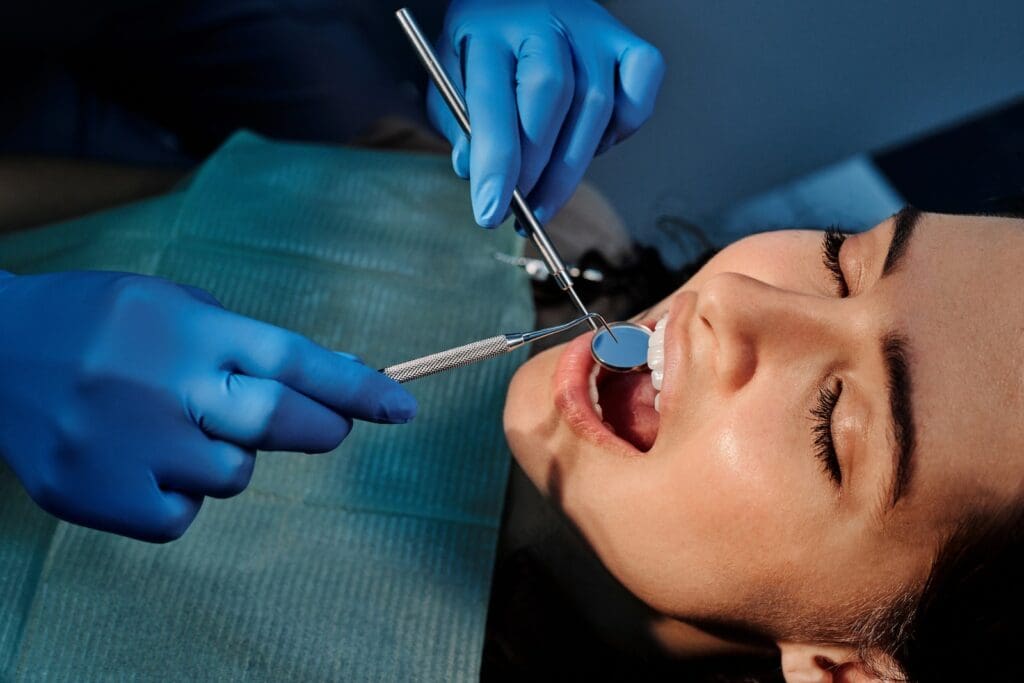
Regular dental checkups are an essential part of maintaining good oral health. However, there is no one-size-fits-all answer to how often you should visit the dentist. The frequency of dental visits depends on various factors, including your age, oral health, and risk of developing dental problems.
According to Delta Dental, the general recommendation in the United States is to visit the dentist once or twice a year for routine dental exams. However, this interval may not be suitable for everyone. People at low risk of oral diseases may need to visit the dentist less frequently, while those at higher risk may need to go more often. Factors that increase the risk of dental problems include smoking, poor oral hygiene, and certain medical conditions such as diabetes.
Understanding the Importance of Dental Visits
Regular dental visits are an essential part of maintaining good oral hygiene and overall health. A dentist can help identify and treat any dental issues before they become more severe, preventing more significant problems down the line.
Visiting a dentist regularly is especially crucial for individuals who are at higher risk for dental problems, such as those with a history of gum disease or tooth decay. However, even individuals with healthy teeth and gums should see a dentist at least once a year.
During a dental visit, a dentist will perform a thorough examination of the mouth, teeth, and gums. They will also clean the teeth and gums, removing any plaque or tartar buildup that can lead to tooth decay or gum disease. A dentist may also take X-rays to check for any underlying dental issues that may not be visible during a visual exam.
In addition to preventing dental problems, regular dental visits can also help identify other health issues. A dentist may notice signs of oral cancer, diabetes, or other systemic diseases during an examination.
Overall, preventive care is essential for maintaining good dental and overall health. By visiting a dentist regularly and practicing good oral hygiene habits at home, individuals can reduce the risk of dental problems and maintain a healthy smile.
Recommended Frequency of Dental Checkups
Regular dental checkups are essential for maintaining good oral health. The American Dental Association (ADA) recommends visiting the dentist at least once a year for an annual checkup. However, the frequency of dental checkups can vary depending on an individual’s oral health needs.
For most people, a biannual check-up every six months is recommended. This schedule allows the dentist to monitor oral health and identify any potential problems early on. People who are at higher risk of developing dental problems, such as those with a history of gum disease or tooth decay, may need to visit the dentist more frequently.
It is important to note that the frequency of dental checkups should be determined on an individual basis. Factors such as age, oral hygiene habits, and overall health can all play a role in determining how often a person should see the dentist.
In addition to regular check-ups, it is important to schedule a dentist appointment if you experience any oral health problems, such as tooth pain or bleeding gums. Prompt treatment can help prevent more serious problems from developing.
Overall, the ADA’s recommendation of an annual checkup is a good rule of thumb for most people. However, it is important to work with your dentist to determine the frequency of checkups that is best for your individual needs.
Factors Influencing Dental Visit Frequency
The frequency of dental visits can vary depending on several factors. While the general guideline suggests twice-yearly visits, individual factors such as oral health conditions and age may influence the ideal visit frequency. Regular check-ups allow for preventive care, early detection of dental issues, and professional cleanings that complement daily oral hygiene practices.
Risk Factors for Dental Disease
People with a greater risk of dental disease and other health conditions may need to see the dentist every three months or more. This higher-risk group includes pregnant women, smokers, people with diabetes, people with a weak immune response to bacterial infection, people with a history of gum disease, people with a tendency to get cavities or plaque buildup, and people with a genetic predisposition to dental problems.
Gum Problems
Gum problems such as gingivitis and periodontitis can lead to bone loss and tooth loss if left untreated. People with gum problems may need to see the dentist more frequently than twice a year to prevent further damage. The dentist will evaluate the severity of the gum disease and recommend a treatment plan that may include deep cleaning, medication, or surgery.
Dental Problems
People with dental problems such as decay, cavities, and broken teeth may need to see the dentist more frequently to prevent further damage. The dentist will evaluate the severity of the dental problem and recommend a treatment plan that may include fillings, crowns, or root canals.
Oral Cancer
Oral cancer is a serious condition that can be life-threatening if not detected early. Regular dental visits can help detect oral cancer in its early stages. People with a history of oral cancer or other risk factors such as tobacco or alcohol use may need to see the dentist more frequently for oral cancer screening.
In summary, the frequency of dental visits depends on individual factors such as oral health conditions, age, and risk factors for dental disease. Regular check-ups are important for preventive care, early detection of dental issues, and professional cleanings that complement daily oral hygiene practices.
The Role of Oral Hygiene Habits
Maintaining good oral hygiene habits is crucial in preventing dental problems and reducing the frequency of dental visits. Daily brushing and flossing are essential in removing food particles and plaque from the teeth and gums. Plaque is a sticky film of bacteria that can accumulate on teeth and gums, leading to tooth decay and gum disease.
Brushing twice a day with fluoride toothpaste is recommended by dental professionals to remove plaque and prevent tooth decay. It is important to brush for at least two minutes and to use a soft-bristled toothbrush to avoid damaging the gums and tooth enamel. Interdental brushes and oral irrigators can also be used to remove plaque from hard-to-reach areas.
Flossing daily is also important in removing plaque and food particles from between the teeth and along the gum line. It is recommended to use a piece of floss that is about 18 inches long and to wrap it around the index fingers of both hands, leaving about two inches of floss between them. Gently slide the floss between the teeth, using a back-and-forth motion. Be sure to curve the floss around each tooth and slide it under the gum line.
In addition to brushing and flossing, maintaining a healthy diet and limiting sugary food and drinks can also help prevent tooth decay and gum disease. Regular dental check-ups and cleanings are also important in maintaining good oral hygiene and detecting any dental problems early on.
Overall, practicing good oral hygiene habits can help prevent dental problems and reduce the need for frequent dental visits.
Special Considerations for Different Groups
Maintaining good oral health is important for everyone, but certain groups may require more frequent dental check-ups and cleanings. Here are some special considerations for different groups:
Children
Children should see a dentist as soon as their first tooth comes in or by their first birthday, whichever comes first. After that, dental check-ups should occur as often as the dentist advises, with a typical recommendation of every six months to a year. Children who are at high risk for tooth decay may need to see the dentist more often.
Adults
Most adults should visit the dentist every six months for a routine check-up and cleaning. However, individuals with a history of gum disease or who are at risk for gum disease may need to see the dentist more often. Smokers are also at a higher risk for gum disease and may need more frequent dental visits.
Pregnant Women
Pregnant women should continue to see their dentist for routine check-ups and cleanings during pregnancy. In fact, it is especially important for pregnant women to maintain good oral health, as gum disease has been linked to preterm birth and low birth weight.
Diabetics
Diabetics are at a higher risk for gum disease, so it is important for them to see the dentist regularly. In addition to routine check-ups and cleanings, diabetics may need more frequent deep cleanings to remove plaque and tartar buildup.
Family History
Individuals with a family history of dental problems may need to see the dentist more often. For example, if a parent or sibling has had gum disease, the individual may be at a higher risk and may need more frequent dental check-ups and cleanings.
In conclusion, the frequency of dental check-ups and cleanings can vary depending on individual needs and risk factors. It is important to follow the dentist’s recommendations and maintain good oral hygiene habits at home to ensure optimal oral health.
Financial Aspects of Dental Visits
Visiting a dentist regularly is important for maintaining good oral health. However, the costs associated with dental visits can be a concern for many people. The cost of a dental visit can vary depending on various factors such as the location, the dentist, the type of procedure, and whether or not the patient has insurance.
For patients with dental insurance, the cost of dental visits can be significantly reduced. Dental insurance plans typically cover preventive services such as routine cleanings and checkups. However, the coverage for other services such as fillings, crowns, and root canals may vary depending on the plan. It is important for patients to review their insurance plan and understand what services are covered and what their out-of-pocket costs will be.
For patients without dental insurance, the cost of dental visits can be a concern. However, there are options available to help reduce the cost. Some dental clinics offer discounted rates for patients without insurance. Patients can also look into dental savings plans, which are similar to insurance plans but typically have lower premiums and cover a wider range of services.
It is important for patients to prioritize their oral health and not let financial concerns prevent them from visiting a dentist. Regular dental visits can help prevent more serious dental problems from developing, which can ultimately save patients money in the long run. Patients should talk to their dentist and explore their options to find a solution that works for them financially.
Understanding the Dental Checkup Process
Regular dental checkups are essential for maintaining good oral health. During a dental checkup, a dentist or dental hygienist will examine your teeth, gums, and mouth to check for any signs of problems. This section will provide an overview of what to expect during a typical dental checkup.
Exam
The dental exam is the first step in a dental checkup. The dentist or dental hygienist will visually examine your teeth, gums, and mouth for any signs of problems, such as tooth decay, gum disease, or oral cancer. They may also use a dental mirror and probe to examine hard-to-reach areas of your mouth.
Cleaning
After the exam, the dental hygienist will perform a thorough cleaning of your teeth. This involves removing any plaque or tartar buildup on your teeth using special tools. They will also floss your teeth to remove any food particles or plaque between your teeth.
X-Rays
In some cases, the dentist may need to take x-rays of your teeth to check for any problems that may not be visible during the visual exam. X-rays can help detect tooth decay, gum disease, and other oral health problems.
Treatment
If the dentist or dental hygienist detects any problems during the exam, they may recommend treatment. This may include fillings for cavities, root canals for infected teeth, or other dental work.
Fluoride
After the cleaning, the dental hygienist may apply fluoride to your teeth. Fluoride helps strengthen your tooth enamel and can help prevent tooth decay.
Tartar
If you have a lot of tartar buildup on your teeth, the dental hygienist may use a special tool to remove it. Tartar is hardened plaque that can cause gum disease and other oral health problems.
Overall, it is recommended that adults visit the dentist at least once a year for a dental checkup. However, the frequency of dental checkups may vary depending on your individual oral health needs. By maintaining regular dental checkups, you can help prevent oral health problems and maintain a healthy smile.
Common Dental Issues and Their Signs
Regular dental checkups can help identify and prevent dental issues before they become serious. Here are some common dental problems and their signs that may indicate a visit to the dentist is necessary:
Stains
Stains on teeth can be caused by a variety of factors, including food and drink consumption, smoking, and poor oral hygiene. Signs of stains include discoloration on the surface of teeth, and in some cases, brown or yellow spots. Regular brushing and flossing can help prevent stains, but professional cleaning by a dentist may be necessary to remove stubborn stains.
Dry Mouth
Dry mouth, or xerostomia, occurs when there is a decrease in saliva production. This can be caused by medications, certain medical conditions, or simply aging. Signs of dry mouth include a dry, sticky feeling in the mouth, difficulty swallowing or speaking, and bad breath. A dentist can recommend treatments or products to help alleviate dry mouth symptoms.
Bleeding Gums
Bleeding gums can be a sign of gingivitis, a mild form of gum disease caused by plaque buildup. Other signs of gingivitis include red, swollen gums and bad breath. If left untreated, gingivitis can lead to more serious gum disease. Regular dental cleanings and proper oral hygiene can help prevent and treat gingivitis.
Tooth Pain
Tooth pain can be caused by a variety of factors, including tooth decay, gum disease, or injury. Signs of tooth pain include a sharp or throbbing pain in the affected tooth, sensitivity to hot or cold temperatures, and swelling or redness around the affected tooth. A dentist can diagnose the cause of tooth pain and recommend appropriate treatment.
Sensitivity
Tooth sensitivity can be caused by a variety of factors, including tooth decay, gum recession, or enamel erosion. Signs of sensitivity include a sharp pain when consuming hot or cold foods or beverages, or when brushing or flossing. A dentist can recommend treatments or products to help alleviate sensitivity.
Gum Infection
Gum infections can be caused by a buildup of plaque and bacteria on the teeth and gums. Signs of gum infection include red, swollen gums that bleed easily, bad breath, and a foul taste in the mouth. If left untreated, gum infections can lead to more serious gum disease. Regular dental cleanings and proper oral hygiene can help prevent and treat gum infections.
Calculus
Calculus, or tartar buildup, occurs when plaque hardens on the teeth. Signs of calculus include yellow or brown spots on the teeth, and a rough or bumpy feeling on the surface of the teeth. Regular dental cleanings can help remove calculus buildup and prevent further buildup.
Oral Diseases
Oral diseases, such as oral cancer, can be caused by a variety of factors, including tobacco and alcohol use, poor oral hygiene, and genetics. Signs of oral diseases include sores or lesions in the mouth, difficulty swallowing or speaking, and changes in the appearance of the tongue or gums. Regular dental checkups can help identify and treat oral diseases early.
Lifestyle Factors Affecting Oral Health
Maintaining good oral health is not just about brushing and flossing regularly. Several lifestyle factors can affect oral health, and it is essential to be aware of them to keep your teeth and gums healthy.
Habits
Habits such as nail-biting, teeth grinding, and chewing on ice or hard candy can damage teeth. Additionally, using teeth as tools to open bottles or packages can also lead to cracks and chips.
Adults
As people age, they become more susceptible to gum disease and tooth decay. This is because the gums tend to recede as we age, exposing the roots of the teeth, which are more vulnerable to decay.
Smoking
Smoking is one of the most significant risk factors for gum disease and tooth loss. It can also cause bad breath and staining of the teeth.
Alcohol
Heavy alcohol consumption can lead to dry mouth, which can cause tooth decay and gum disease. Additionally, alcohol can erode the enamel on teeth, leading to sensitivity and discoloration.
Sugar
Consuming sugary foods and drinks can lead to tooth decay. Bacteria in the mouth feed on sugar, producing acids that can erode the enamel on teeth.
Tobacco
Tobacco use, including smoking and chewing tobacco, can cause gum disease, tooth loss, and oral cancer. It can also lead to bad breath and staining of the teeth.
Overall, it is important to be aware of these lifestyle factors and take steps to minimize their impact on oral health. This includes avoiding harmful habits, practicing good oral hygiene, and making healthy choices when it comes to diet and lifestyle.
Conclusion
In conclusion, the frequency of dental visits depends on a variety of factors, including age, oral health history, and current oral health status. While the American Dental Association recommends visiting the dentist at least once every six months, this may not be necessary for everyone.
For individuals with a low risk of oral diseases, visiting the dentist less frequently may be appropriate. However, those with a higher risk of oral diseases, such as smokers or individuals with a history of gum disease, may need to visit the dentist more often.
It is important to note that regular dental checkups are crucial for maintaining good oral health. These visits can help detect potential issues early on, before they develop into more serious problems. Additionally, dental cleanings can remove plaque and tartar buildup, which can lead to tooth decay and gum disease if left untreated.
dUltimately, the decision of how often to visit the dentist should be made in consultation with a dental professional. By discussing individual needs and risk factors with a dentist, individuals can develop a personalized dental care plan that meets their specific needs and helps maintain optimal oral health.



